John Boyd, 1852 – 1929
by Brian Stevenson
last updated June, 2018
John
Boyd was a relatively well-off Victorian-Edwardian industrialist and amateur
microscopist. He was an early member and officer of the Manchester
Microscopical Society, the Literary and Philosophical Society of Manchester,
and other microscopy clubs. He
also amassed what appears to have been a considerable library of microscope
slides. Some were probably of his own make, while others were acquired by
trading with other microscopists. Boyd’s collection included quite a few slides
that came from the personal collection of professional slide maker
Edward Ward, possibly after Ward’s death in 1901. Boyd and Ward were colleagues for many years in the Manchester Microscopical Society.
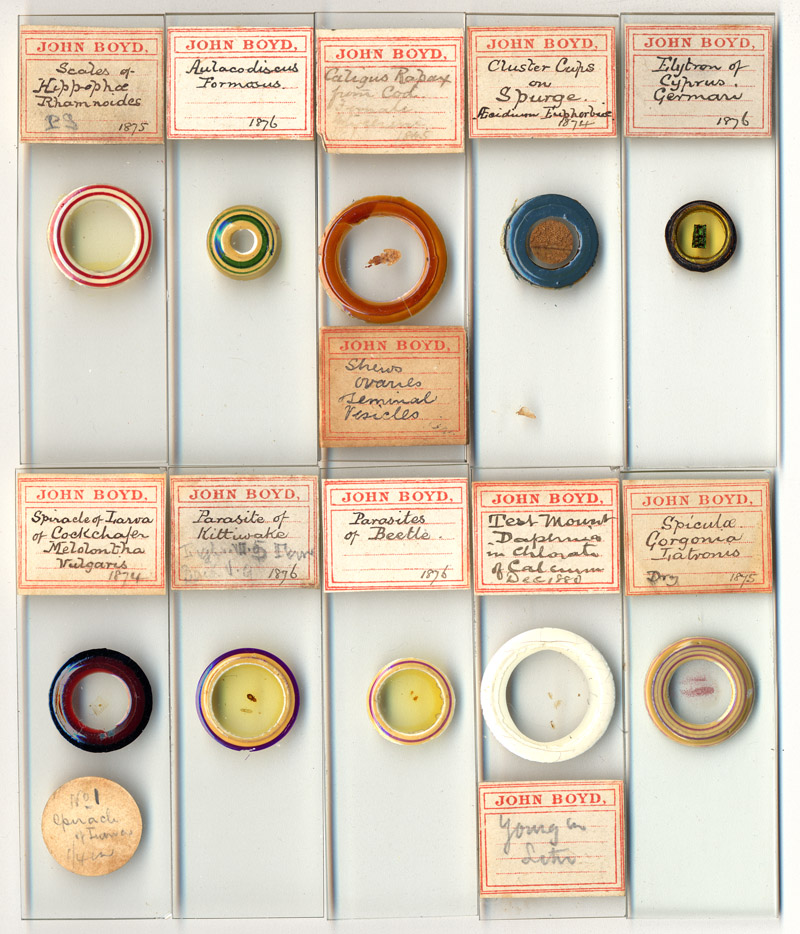
Figure 1. Several microscope slides that bear John Boyd’s
label. The wide variety of ringing styles and colors may be due to their
acquistion from other microscopists. However, the Manchester Microscopical
Society had frequent classes on slide making, so it is equally probable that
the variations stemmed from techniques learned over Boyd’s many decades as a
member of that Society.
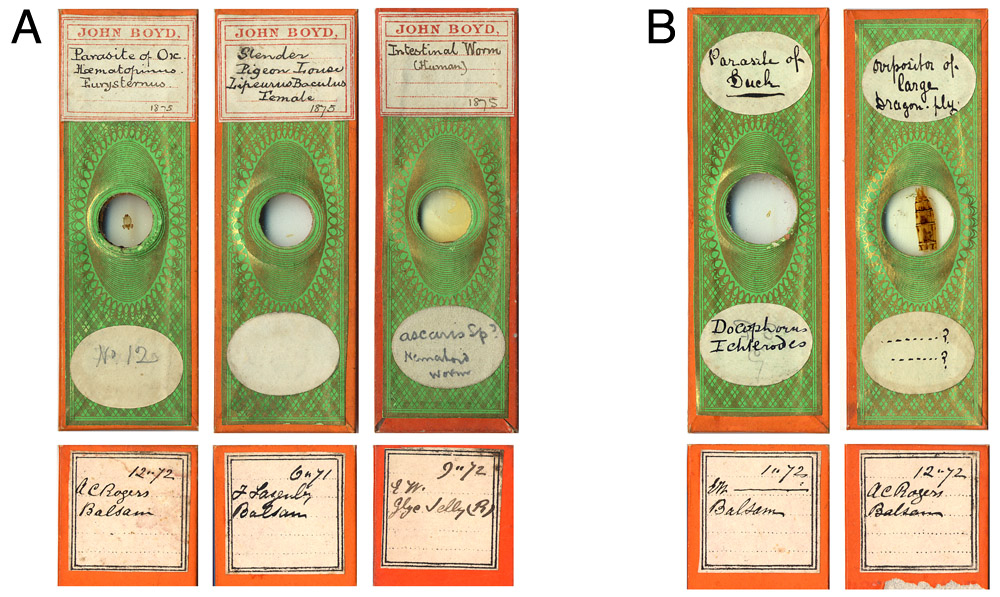
Figure 2.
(A)
Examples of papered slides with John Boyd’s personalized label. The handwriting
on the square labels matches that on other Boyd-labeled slides (see Figure 1).
Many of these slides have additional labels or writing on the back, in a
different hand, listing names, dates and mounting media (snippets are shown
below each slide front).
(B) Such
labels, written in the same hand, are also often found on the reverse of slides
that do not have Boyd’s label, but instead have oval labels written in another
hand. Close examination of Boyd-labeled slides such as those in panel A
frequently reveals an oval paper label or traces of glue in an oval shape underneath Boyd’s label. Handwriting
comparisons indicate that the oval labels were written out by Edward Ward, and
suggest that Boyd acquired the slides in panel A from Ward’s collection.
John
Boyd was born in Manchester, England during the Autumn of 1852. He was the
third son of James and Isabella Boyd. James was originally from Scotland, but
by the time of John’s birth was a cotton yarn merchant in Manchester. Isabella,
and all of their children, were born in Lancashire. The 1861 and 1871 censuses
record the family as living in Chorlton upon Medlock, Lancashire. At the time
of the 1871 census, 18 year old John was recorded as being a salesman, possibly
for his father’s firm.
John
evidently had developed an interest in microscopy by his early twenties. In
1874, he advertised in Hardwicke’s
Science-Gossip for “Well-mounted
Diatomaceae, Zoophytes, Palates, Sections, Spicula, &c., for mounted
Parasites, showing all the legs.” His address was given as Victoria Park,
Manchester. It is notable that
Boyd was offering to provide slides of parasites, since fleas, lice, ticks and
the like were a passion of his, as evidenced by his frequent lectures on
parasites through the following years.
In 1875,
John Boyd was instrumental in the restoration of the “Leeuwenhoek Microscopical
Club” of Manchester. That club was founded in 1867, and consisted of only a
small number of members. From A Review of the Work of the Leeuwenhoek
Microscopical Club: “Throughout its
existence the Club has limited its membership to just that number which its
members could conveniently accommodate in each other’s house and seat around a
common table; but, generally, at the meetings there has been room for one or
two guests. There has never been a
period when it could not have enlarged its borders; but a doubling of the
number of its members would, in most cases, have proved inconvenient for
accomodation in a private house, and would, besides, have consumed too much
time in the examination of the suite of objects prepared to illustrate the
special study of the evening. It has been found by experience that six or eight
persons, with two or three microscopes revolving in order within the circle,
make the happy medium for the most effective consideration and discussion of
the many points which arise during the demonstration of any practical subject.” The club’s first President was the Reverend John E. Vize, who later achieved fame as a mycologist. The small number of
members led to the suspension of the club’s meetings in 1873, after several
members resigned due to business obligations, moving away, etc. On Sept. 30, 1875, the club reorganized
with a membership of five, including John Boyd. He was elected Secretary, and later served as President from
1890-91. Boyd was also noted in
the club archives as having developed a simple rotating table-top platform for
moving microscopes from one viewer to another. This club, and probably others
of which Boyd was a member, also contributed to his growing collection of microscope
slides. The Review notes that “at all
these meetings the exchange of slides illustrating the selected subjects of
study, or novel modes of mounting, was observed for many years…the cabinets of
the members were thus enriched with many valuable slides, which in some cases
remain as mementoes of friends passed away”.
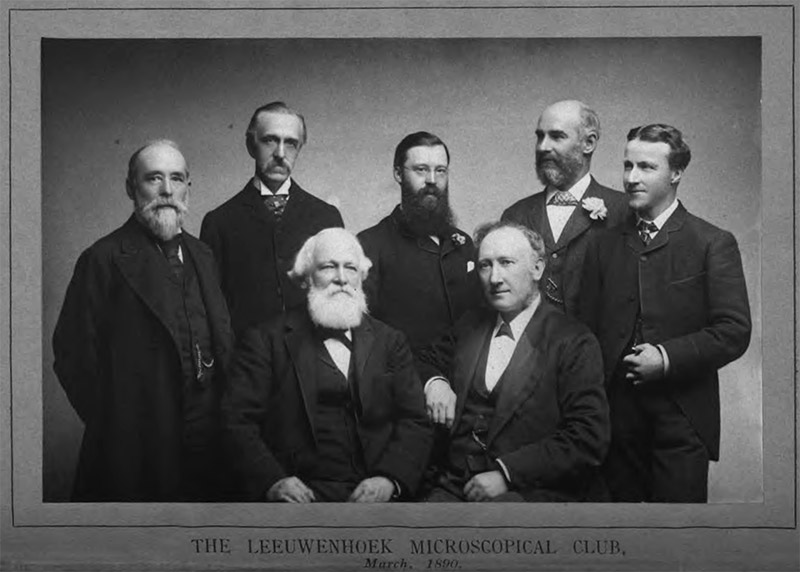
Figure 3. The Leeuwenhoek Microscopical Club, March 1890. The gentlemen can be identified from other photographs of them, and their ages at the time. Left to right, Mark Stirrup, William Blackburn, John Barrow, John Boyd (see Figure 5, below), John Tatham, Charles Bailey, and John B. Pettigrew. Slides with the labels of Charles Bailey, John Barrow and John Tatham are illustrated in Figure 4, below.
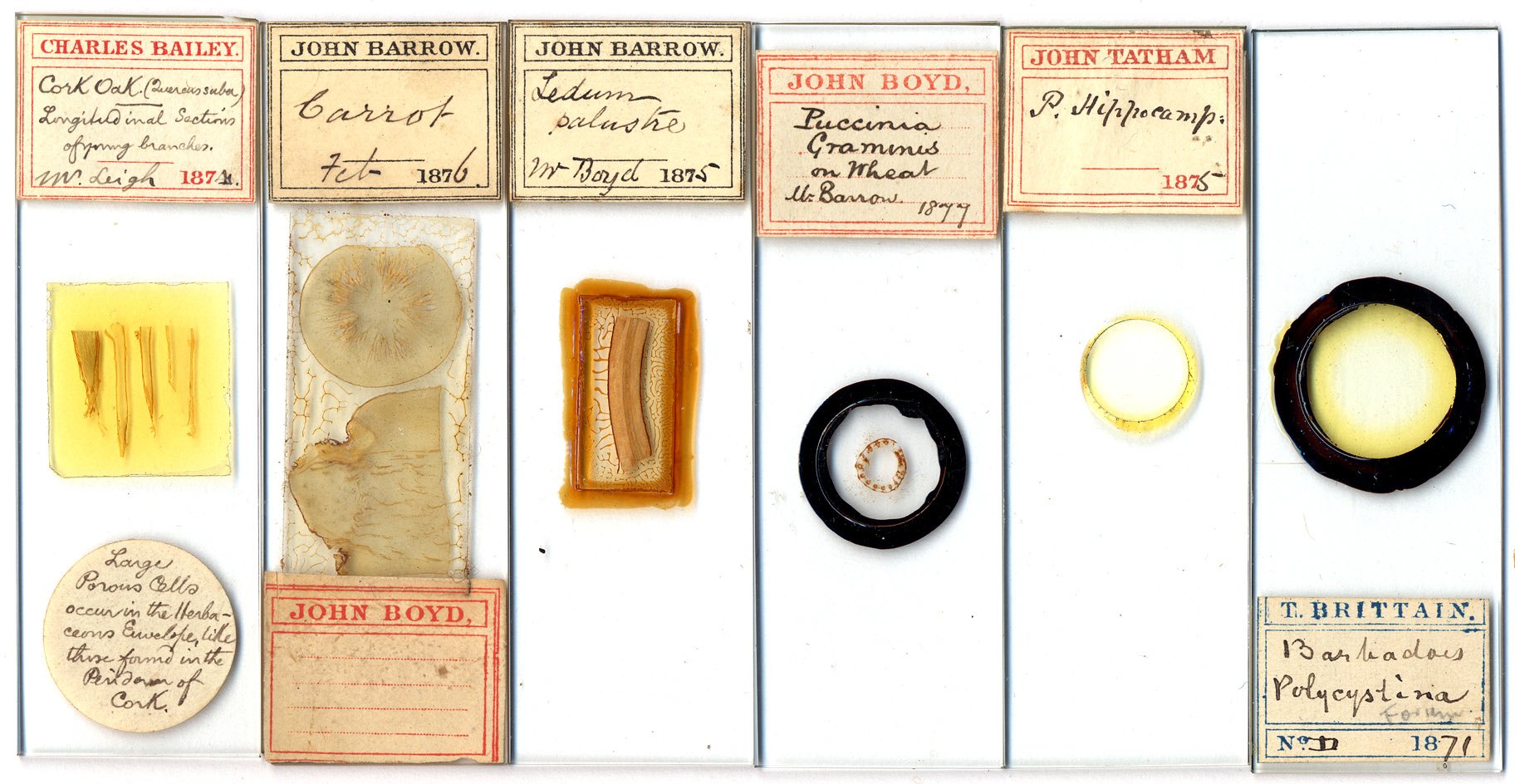
Figure 4. Examples of microscope slides once owned by John Boyd’s colleagues in the Leeuwenhoek Microscopical Club and the Manchester Microscopical Society. Left to right: Charles Bailey, sections of cork oak; John Barrow, sections of carrot, apparently given to John Boyd; John Barrow, section of Ledum, given to him by John Boyd; Puccinia fungus, with Boyd’s label, which was given to him by Barrow; John Tatham, diatoms; and Thomas Brittain, polycystina. It appears that all these colleagues used the same printer to make their labels.
Through
1875, Boyd continued to advertise for slides and specimens. Ads in Science-Gossip offered “Well-mounted Objects exchanged for Parasites
and their Eggs” and “Well-mounted
Slides or good Material for mounting; for unmounted Animal Parasites, in
spirits.” I have not located exchange ads from Boyd after 1875, even with
thorough searches of subsequent issues of Science-Gossip.
It may be that his clubs or established contacts provided Boyd with a
sufficient supply of new slides from then on.
In
1875, John Boyd was elected an Ordinary Member of the Literary and
Philosophical Society of Manchester. The following year he was elected a Member of the Society’s Microscopical
and Natural History Section. On Dec. 3, 1877, Boyd presented to the Section on
“the Chiego or ‘Jigger’ Flea (Pulex
penetrans, L.) from Demerara ”, and exhibited specimens of that
flea and of the human and cat fleas P. irritans and P. felis. The
following February, he exhibited slides of a fresh water sponge. In April,
1878, Boyd was elected a member of the Council of the Microscopical
and Natural History Section. His colleague from the Leeuwenhoek club, Charles
Bailey, was then Chairman of the Section.
The
small size of the Leeuwenhoek Microscopical Club’s membership led Thomas Brittain, who had been a frequent guest of that club, to form the Manchester
Microscopical Society in the year 1880. John Boyd was an original member, and
was elected as the club’s President in 1881.
Boyd
continued to present microscopical slides and lectures to his clubs, with a
bias toward blood-sucking arthropods. On March 15, 1880, he presented to the
Microscopical and Natural History Section “on
the Haustellum of the Haustellata, with diagrams, and also exhibited some
microscopical slides illustrative of the subject” (‘haustellata’ is an
artificial division of insects, including all those with a sucking
proboscis). On Nov. 18 of that
year, he exhibited to the Manchester Microscopical Society “some camera lucida drawings of Vaginicola
valvata; the long posterior-spine Daphnia Schaeferi, and also of Chydorus
sphaericus, all of which he had taken in Derwentwater.” On Feb. 3, 1881, he
exhibited and spoke on the “Ixodes (tick) of the Tortoise”, and on March 3 about “a
parasite from the skin of man, Demodex folliculorum; this was also illustrated
by a diagram prepared by Mr. Boyd.” At that year’s Manchester Microscopical
Society Annual Soiree, members exhibited “by
means of microscopes, which were placed on tables, arranged around the room, a
variety of objects illustrative of pond life, and other branches of the animal
and vegetable world, as well as preparations from the mineral kingdom. There
were present a large number of members and friends. During the evening the Rev.
J.G. Wood, M.A., delivered a lecture on Unappreciated Insects.” That night,
President Boyd exhibited a “live flea”,
“eggs of parasite of partridge” and “parasite of a fish (alive).” At the 1882
Soiree, Boyd exhibited “mange insect”,
“body louse”, “Daphnia pulex”, “Cyclops
quadricornis infested with Epistylis digitalis”, and “crab louse of man.”
A modern day collector of antique microscopes would love to have seen “the excellent display made by members, both
before and after the lecture. Over fifty microscopes had been set up, and under
each was shown some interesting object. The variety of stands was worthy of a
careful inspection. The best
English and Continental makers were well represented. The first-class stands of
Ross, Powell and Lealand, Smith and Beck, Swift, Crouch, and Zeiss; while
serviceable and good students’ stands were also shown by Messrs. Ward and
Aylward, of Manchester.”
One last story from Boyd’s long involvement in microscopy: on May 4, 1881, “Mr. John Boyd made a communication, in which
he stated that most Microscopists are familiar with the story that on a certain
old church-door some nails were shewn fastening what appeared to be fragments
of leather, and that tradition stated that the skin of a felon who had been
flayed had been nailed to the door. These portions of leather were examined
under the microscope, and were found to be really human skin, proving the correctness
of the tradition. Quite recently a circumstance came under my notice, in some
respects similar. That is to say, that a statement made as to a certain object
was proved to be correct from microscopical examination. I was visiting in a
country house in Scotland, and one day, to amuse a child who was playing about
in the room, a peculiar carved stool was brought out. It was of a very unusual
shape, narrow at the bottom, and broader and wider at the top ; and this top
instead of being flat was hollowed out. The material was the twin-trunk of a
small tree. It was said to have been brought by a missionary from Africa, and
although apparently a stool was really a pillow. As is well known to you, many
tribes dress their hair into most extravagant shapes. The process takes a very
long time, and the hair is not again dressed for a month or two. The small
stool is used to support the neck, to prevent the hair being dis-arranged. The
thought at once struck me that such a style of hair dressing would be particularly
conducive to the plentiful propagation of Pediculus capitis (author’s note: the
human head louse), and that I might by careful search find traces of these
interesting and beautiful creatures; and on further examination I discovered
dozens of the small white eggs of this parasite in recesses of the carving on
the little stool. When I announced this, there was quite a commotion, and the
question was asked if there was any danger of the eggs hatching. Evidently for
the moment, the fact of the many years which had elapsed since the stool was
brought from Africa was lost sight of. However, I was able to shew under the
microscope that the little lids which give such a pretty finish to the eggs of
this and of many other parasites were in each lifted off, shewing that the
little tenant had made his exit at some previous time. In mentioning this as another instance
of how microscopic examination, of an object which apparently was of little
interest to the microscopist, may confirm or confute statements made about it.
The missionary's tale about this peculiar little and apparently uncomfortable
stool, being used as a pillow, was abundantly confirmed by the presence of
these eggs.”
John Boyd
lived a long and apparently successful life. By the time of the 1881 census, he
was married to a Scot named Mary, with whom he had a one year old son named
James. They had two live-in domestic servants. John’s profession was “yarn merchant.” By 1991, they had moved
to Barton House, Didsbury, Lancashire, had three children, and John was a “cotton yarn agent.”
Boyd
served the Microscopical and Natural
History Section of the Literary and
Philosophical Society of Manchester in various offices through the 1890s
and into the 20th century. In 1921, Boyd donated 32 volumes of the Society’s Memoirs and Proceedings to that club. In
1923, he donated A Manual of the
Infusoria by W. Saville Kent (6 parts) to the Manchester Microscopical
Society, which appears still to be in their library. Boyd died in 1929, at the
age of 78.
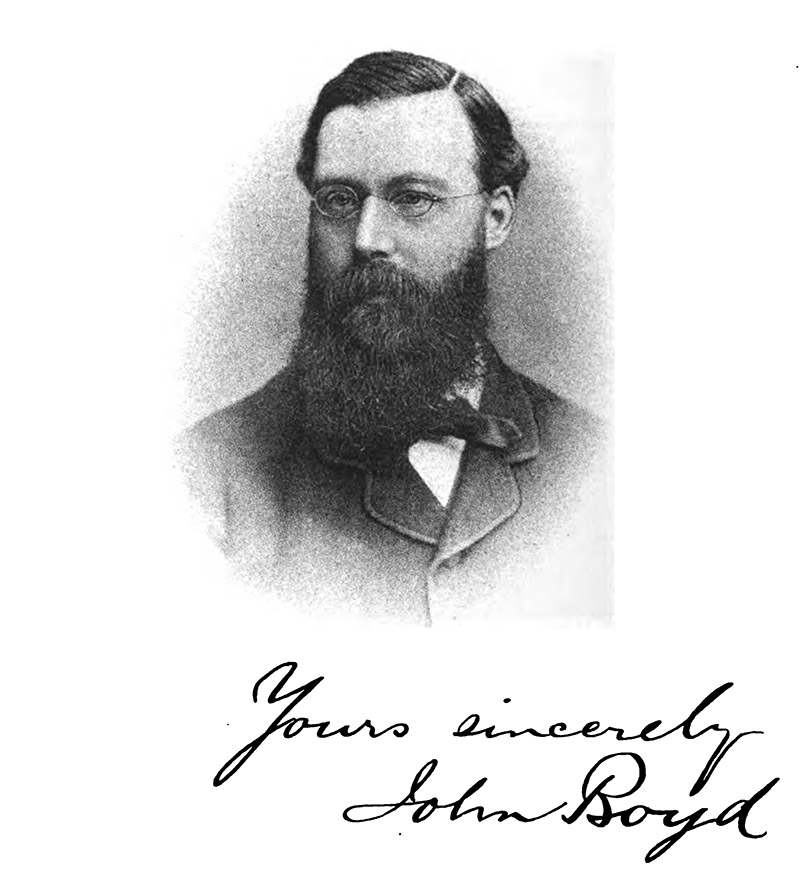
Figure 5. John Boyd, from the 1888 "Transactions and Annual Report of the Manchester Microscopical Society". Boyd was a long-standing member, and served as President in 1881.
Resources
Brian Bracegirdle (1998) Microscopical
Mounts and Mounters, Quekett Microscopical Club, London. pages 13 and 91,
and plates 5-O and 34-F
England census, birth, marriage and death records, accessed
through www.ancestry.co.uk
Hardwicke’s Science-Gossip (1874) Vol. 10, page 284
Hardwicke’s Science-Gossip (1875) Vol. 11, pages 24 and 283
Hardwicke’s Science-Gossip (1877) Vol. 13, page 210.
Manchester Microscopical & Natural History Society web
pages, on line at http://www.manchestermicroscopical.org.uk
Memoirs and Proceedings of the Literary and Philosophical Society of Manchester (1888) Fourth series, Vol. 2, pages 9-10
Memoirs and Proceedings of the Literary and Philosophical Society of Manchester (1891) Fourth series, Vol. 5, pages 60, 91 and 94
Memoirs and Proceedings of the Literary and Philosophical Society of Manchester (1892) Fourth series, Vol. 5, pages 173 and 204
Memoirs and Proceedings of the Literary and Philosophical Society of Manchester (1895) Fourth series, Vol. 9, pages 15-17 and 191
Memoirs and Proceedings of the Literary and Philosophical Society of Manchester (1898) Vol. 42, pages xxvi, xxviii and lxviii
Memoirs and Proceedings of the Literary and Philosophical Society of Manchester (1902) Vol. 46, pages xxxviii and xlvi
Memoirs and Proceedings of the Literary and Philosophical Society of Manchester (1921) Vol. 54,
Memoirs and Proceedings of the Literary and Philosophical Society of Manchester (1923)
The Northern Microscopist (1881) Vol. 1, January, pages 16, 63, 94-95,
and 116-119
The Northern Microscopist (1882) vol. 2, pages 73, 97-98, and 159-161
Proceedings of the Literary and Philosophical Society of Manchester (1875-76) Vol. 15, pages 19 and 134
Proceedings of the Literary and Philosophical Society of Manchester (1876-77) Vol. 16, page 90
Proceedings of the Literary and Philosophical Society of Manchester (1877-78) Vol. 17, pages 104 and 228
Proceedings of the Literary and Philosophical Society of Manchester (1878-79) Vol. 18, page 130
Proceedings of the Literary and Philosophical Society of Manchester (1879-80) Vol. 19, page 155
Proceedings of the Literary and Philosophical Society of Manchester (1883-84) Vol. 23, page 79
Proceedings of the Literary and Philosophical Society of Manchester (1884-85) Vol. 24, page 49
A Review of the Work of the Leeuwenhoek Microscopical Club, Manchester, From October, 1867, to March, 1891. in
Pamphlets on
Protozoology (Kofoid Collection), Vol. 298, page 323, , on line at http://books.google.com/books?id=jmA0AAAAIAAJ




